Keeping Current Matters | Nov 1, 2023
Maybe you’re in the market for a home and are having a hard time finding the right one that fits your budget. Or perhaps you’re already a homeowner in need of extra income or a place for loved ones. Whether as a potential homebuyer or a homeowner with changing needs, accessory dwelling units, or ADUs for short, may be able to help you reach your goals.
What Is an ADU?
As AARP says:
“An ADU is a small residence that shares a single-family lot with a larger, primary dwelling.”
“An ADU is an independent, self-contained living space with a kitchen or kitchenette, bathroom and sleeping area.”
“An ADU can be located within, attached to, or detached from the main residence. It can be created out of an existing structure (such as a garage) or built anew.”
If you’re thinking about whether an ADU makes sense for you as a buyer or a homeowner, here’s some useful information and benefits that ADUs can provide. Keep in mind, that regulations for ADUs vary based on where you live, so lean on a local real estate professional for more information.
The Benefits of ADUs
Freddie Mac and the AARP identify some of the best features of ADUs for both buyers and homeowners:
- Living Close by, But Still Separate: ADUs allow loved ones to live together while having separate spaces. That means you can enjoy each other’s company and help each other out with things like childcare, but also have privacy when needed. If this appeals to you, you may want to consider buying a home with an ADU or adding an ADU onto your house. According to Freddie Mac:
“Having an accessory dwelling unit on an existing property has become a popular way for homeowners to offer independent living space to family members.”
- Aging in Place: Similarly, ADUs allow older people to be close to loved ones who can help them if they need it as they age. It gives them the best of both worlds – independence and support from loved ones. For example, if your parents are getting older and you want them nearby, you may want to buy a home with an ADU or build one onto your existing house.
- Affordable To Build: Since ADUs are often on the smaller side, they’re typically less expensive to build than larger, standalone homes. Building one can also increase your property’s value.
- Generating Additional Income: If you own a home with an ADU or if you build an ADU on your land, it can help generate rental income you could use toward your own mortgage payments. It’s worth noting that because an ADU exists on a single-family lot as a secondary dwelling, it typically cannot be sold separately from the primary residence. But that’s changing in some states. Work with a professional to understand your options.
These are a few of the reasons why many people who benefit from ADUs think they’re a good idea. As Scott Wild, SVP of Consulting at John Burns Research, says:
“It’s gone from a small niche in the market to really a much more impactful part of new housing.”
Bottom Line
ADUs have some great advantages for buyers and homeowners alike. If you’re interested, reach out to a real estate professional who can help you understand local codes and regulations for this type of housing and what’s available in your market.
HouseDigest.com | Feb 22, 2023
Have you ever decided to tackle a cleaning project around the house (perhaps one that you’d been putting off for a while), only to discover that you’re out of the cleaner that you thought you had? It can be beyond frustrating to have to put off what you want to accomplish because you have to grab your keys and run to the store to buy the missing spray or powder.
But believe it or not, several cleaning substitutes, many of which you likely have in your home already, can take the place of store-bought cleaners. And even better, many of these substitutes are safer than their chemical cleanser counterparts, which often include toxic ingredients. Say goodbye to having to ventilate the room while spraying! Read on to learn more about some of the best cleaning substitutes that will take the place of kitchen sprays, bathroom cleaners, stain removers, and so many other store-bought sprays, gels, and powders.
Vinegar in place of kitchen sprays
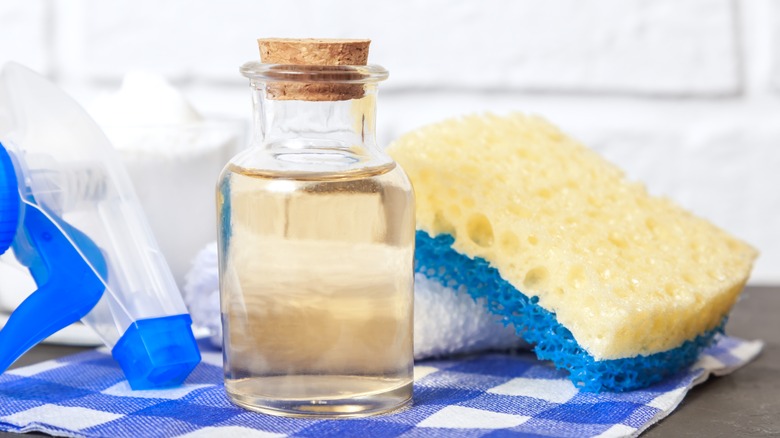
Vinegar is for much more than cooking. It can help with a wide range of cleaning tasks in numerous rooms throughout the home. The best type of vinegar to use for cleaning is distilled white vinegar, which includes 5% acetic acid. While safe enough to handle or even consume, the vinegar’s acidity helps break down and remove gunk on surfaces.
If you’re looking for a substitute for kitchen sprays, either because you ran out of the one you normally use or are looking for something that won’t introduce more chemicals around the areas you cook, look no further than vinegar. To use it to clean the kitchen, mix it with water in a spray bottle using a 1:1 ratio (equal parts of both liquids). Spray the mixture on countertops, cooktops, shelves in the refrigerator, and other surfaces. If there are any particularly sticky or caked-on messes, leave it to sit for a few minutes before wiping the surface down. Because vinegar is non-toxic, you can even use it to clean coffee pots, stainless steel cookware, cutting boards, and other kitchen tools that you wouldn’t want to get anywhere near standard kitchen sprays.
Hydrogen peroxide in place of mold and mildew shower sprays
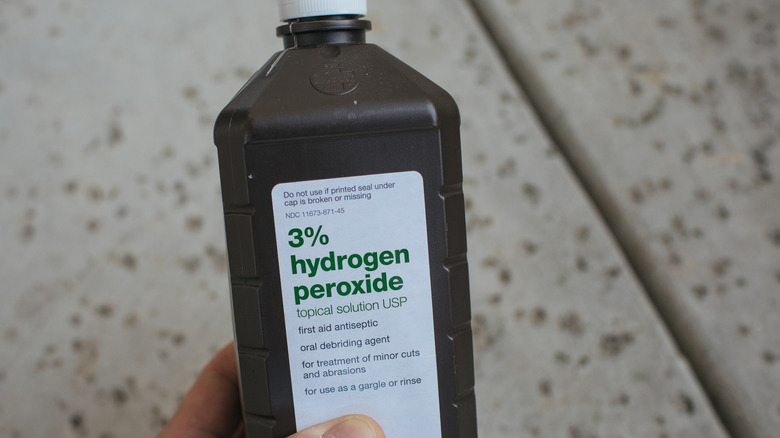
Hydrogen peroxide is another versatile product. You likely have a bottle of hydrogen peroxide in your medicine cabinet or under your bathroom sink for tending to wounds, but did you know that it could also double as a shower spray? If you have areas of mold or mildew along your shower tiles, skip chemical bleach-based cleansers and reach for that bottle of hydrogen peroxide in your medicine cabinet instead. Add it to a spray bottle and spray it directly over moldy or mildewy spots. Leave it to sit for about 10 minutes, then use a scrub brush to clean the tiles. Rinse everything, and your shower should be good as new again.
The reason hydrogen peroxide is such an effective cleaner comes down to its chemical composition. When the bonded hydrogen and oxygen atoms come into contact with surfaces, they create a reaction, loosening gunk and grime and disinfecting the surface. Unlike chemical bathroom cleaners, hydrogen peroxide is non-toxic and will not damage your lungs. If you habitually use more natural cleaning products, just keep in mind that you should never mix hydrogen peroxide and vinegar. According to the Missouri Poison Center, combining these two liquids can cause peracetic acid to form, which could irritate your eyes, skin, or lungs.
Lemon juice in place of glass and window cleaner

Keeping your windows clean and streak-free can be a chore. However, you don’t have to rely on store-bought glass and window cleaners for this task. Instead, you can use lemon juice. It has antibacterial and antiseptic properties, which make it an excellent choice for a range of cleaning tasks. Lemon juice is also acid, which means that it can help breakdown grime, much like vinegar.
The next time you need to clean the windows in your home, try making a DIY glass and window cleaner using lemon. Add about 1 ½ cups of hot water to a spray bottle. Then pour in 3 tablespoons of lemon juice, and gently swirl the bottle to mix the two ingredients. Use this cleaner to spray your windows, then wipe them using a microfiber cloth for a streak-free finish. As a bonus, using lemon juice will leave behind a pleasant fragrance, to make your house smell as clean as your windows will look.
Cornstarch as a carpet stain remover

If you have stains on your carpets from pets, kids, or any other number of causes, fear not. Open your pantry, and you may see the perfect substitute for carpet stain removers. Believe it or not, cornstarch can work well at removing stains and their corresponding odors from your carpets.
To use cornstarch as a stain remover, you’ll want to mix it with a little water or distilled white vinegar. The mixture should be a very thick paste, so take care not to add too much liquid. Once the paste is prepared, spread it over the stain on the carpet and let it sit for several hours until stiff and dry. Once dry, vacuum up the excess cornstarch from the rug (if it is stuck on, you can gently scrape it off using a knife or kitchen scraper before vacuuming). The cornstarch should have absorbed the stain and its odor, leaving your carpet clean. For deep, set-in stains, you may need to repeat the steps above a few times.
Gin or vodka as jewelry cleaners

Did you know gin and vodka can help keep your jewelry clean? In fact, using gin was a trick that some members of Queen Elizabeth’s staff used to swear by when cleaning the royal jewels. Try dipping jewelry with diamonds and other gemstones in a glass with a little bit of gin or vodka. Leave the jewelry to soak for at least four hours.
When you return to pull out your jewelry, you should notice that it looks much cleaner and more brilliant. So, how exactly does alcohol clean diamonds and other stones? The secret lies in the higher ethanol content of these two alcohols. When the gems are left to soak, it acts as a natural solvent, breaking down and getting rid of any grime on the stone. If this cleaning method was good enough for the Queen, it might be worth giving it a shot with your gems and jewels.
Shaving cream in place of stainless steel cleaner

Fear not if your stainless steel appliances always seem to be covered in fingerprints or hard water stains. You don’t have to run out and buy a specialized cleaning product with questionable ingredients. Instead, you can just head to your bathroom cabinet and pull out a can of shaving cream (opt for a basic, fragrance-free formula for best results). Simply cover the stainless steel surfaces with some shaving cream — it doesn’t take too much — then wipe it off using a damp cloth.
Once most of the shaving cream has been removed from the surface, use a clean and dry microfiber towel to finish the job. Rub the surface until the classic stainless shine returns. The shaving cream works to remove the stains (you can leave it to sit for a few extra minutes on hard water spots and stains) and leaves your stainless steel stove, dishwasher, refrigerator, and other appliances looking like new.
Baking soda in place of dish stain removers
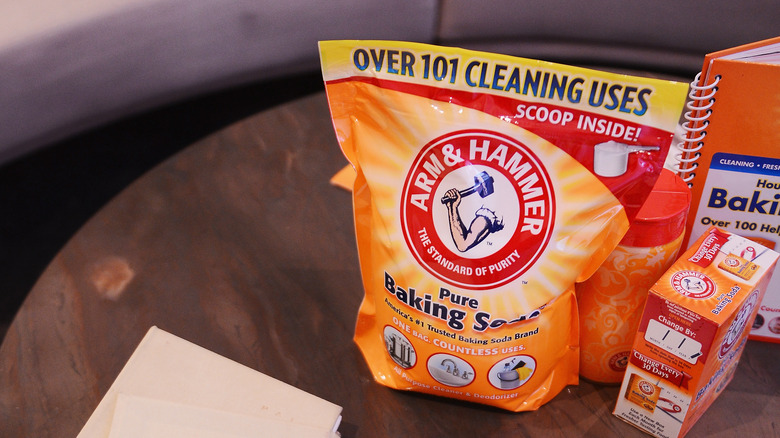
Our mugs, dishware, and plastic storage containers can develop stains over time. Even when we know these items are clean, they can still look dirty and dingy. Baking soda can help you rejuvenate these items throughout your kitchen, giving them a new shot at life. Baking soda is slightly abrasive and works to release the particles that caused the stain. It also absorbs odors, so if any of the stained items also have an unpleasant odor, baking soda should help with that too.
To use baking soda as a stain remover, mix it with a small amount of water and vinegar to form a thick paste. Apply the paste over the stained area, leave it to sit for about half an hour, and then wipe it off with a sponge. If needed, you can repeat the steps an additional time for more stubborn stains. Once the stain is removed, rewash the item as usual before using it. You can use this paste to tackle a variety of stains in the kitchen, including coffee- or tea-stained mugs, stained plasticware, cutting boards, countertops, and more.
Coconut oil as a shower cleaner

If you’re looking for a more natural way to clean your shower and want to stay away from bleach and other harsh chemicals, the solution you need may be sitting in your pantry right now. Coconut oil can actually be used to clean a variety of surfaces, including shower walls and bathtubs. Place some coconut oil on a rag or scrub brush and use it to wipe down all the surfaces in your shower or bathtub. Once that’s done, rinse with warm water, and you should notice that everything looks much cleaner.
The reason coconut oil can be an effective cleaner — and a particularly good choice for showers — is because of the lauric acid found in it. Lauric acid works as an antimicrobial, giving surfaces a thorough cleaning. If you want to boost the power of the coconut oil or tackle any particularly tough stains, try mixing it with some baking soda. As noted above, baking soda is a great stain remover.
Witch hazel in place of floor cleaners

You may have taken witch hazel to relieve symptoms of diarrhea, vomiting, inflammation, skin irritations, and other more serious conditions. The liquid from the witch hazel plant is extracted and then taken orally or applied directly to the skin, depending on the condition. It may seem strange to think that the same substance that can help with medical conditions can also help keep your floors clean, but it is true. You can use witch hazel on tile, vinyl, and linoleum floors, but it isn’t the best solution for your hardwood floors.
Fill your mop bucket with about 1 gallon of warm water. Then, add between ⅓ and ⅔ of a cup of witch hazel and mix it in well. Dip your mop or cleaning brush in the solution, and use it to clean your floor. The witch hazel will help break down dirt and debris, leaving your floors clean and shiny. If you want a quicker, less-involved cleaning job, witch hazel can still help. Instead of mixing a solution in your mop bucket, add some witch hazel and a little bit of water to a spray bottle and spritz the floors in your home before wiping them down with a microfiber towel or mop head.
Toothpaste in place of shoe cleaners

If your white shoes have seen better days, toothpaste may be able to help you rejuvenate them. White, baking soda-based toothpastes — stay away from gels — can work wonders at taking scuff marks and dirt off tennis shoes. An old toothbrush will work as the perfect cleaning tool to complement the toothpaste.
Simply apply a little white toothpaste onto the toothbrush head and use it to tackle any stained or dirty areas on the shoes. Scrubbing in a circular motion will be the most effective way to release stains and messes. After you’ve cleaned all the necessary areas, allow the toothpaste to sit for about 15 minutes, then wipe it off using a damp towel. You may need to repeat the steps above a few times for more stubborn stains. In addition to working well to remove stains from the canvas and fabric parts of shoes, a whitening toothpaste can also be an effective cleaner for the rubber edges of your tennis shoes. Apply it to these areas with a toothbrush, following the same methods described above.
Borax as toilet bowl cleaner

No one enjoys cleaning the toilet, but it is one of those tasks that we just can’t skip. However, you can skip the bleach- and chemical-based cleaners you want to keep out of your house. The ideal substitute may be waiting in your laundry room right now. Borax is traditionally used as a laundry booster, but its chemical makeup also makes it an effective toilet bowl cleaner. With its pH of 9.5, it is on the alkaline side. That means it can work to remove a variety of substances, such as oils, fats, and anything acidic, when mixed with water.
To use Borax as a toilet bowl cleaner, add approximately 1 cup to the water in your toilet bowl at night. Dump it in slowly, trying to get some of the powder to coat the sides of the toilet. You may even want to put on gloves to apply some of it along the toilet’s upper rim to achieve a thorough clean. Once the Borax powder has been applied to the inside of the toilet bowl, let it sit there for several hours, ideally overnight. When you wake up, take your toilet brush and give the inside of the bowl and along the rim a good scrubbing. Flush and admire how effective the Borax was at getting rid of stains.
Fabric softener as baseboard cleaner
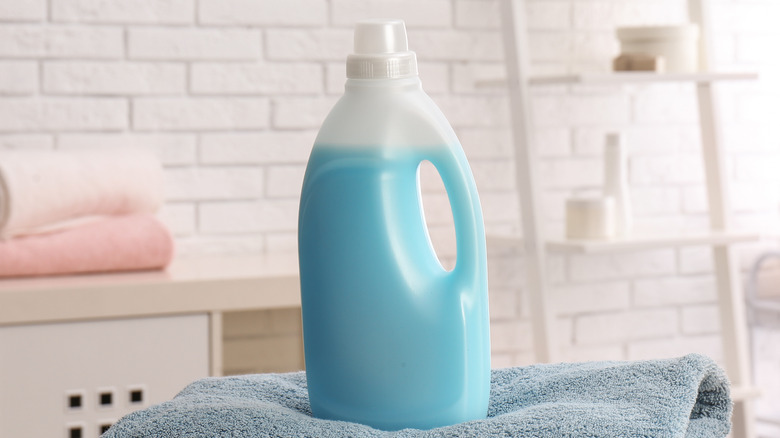
Baseboards can get dirty so easily. After all, they’re right along the floor where dirt and other gunk get tracked in. Another item that is probably in your laundry room right now can help you tackle this cleaning task. Try cleaning your baseboards with fabric softener, and you won’t want to go back to whatever cleaners you used to use. Not only is fabric softener an effective cleaner for this task, but it is also really easy to use.
Transfer a little of your fabric softener out of the bottle and into a spray bottle. You’ll want to be able to control how much comes out, which won’t be possible with the wide open mouth on the package you get from the store. You’ll want to add approximately 1/2 a cup of fabric softener and about 2 ½ cups of water. Put the lid on the spray bottle and gently swirl the mixture to combine the two ingredients.
Spray the mixture directly on your baseboards, then go around with a dry microfiber cloth to wipe them down. For carpeted rooms, you may only want to spray a small section at a time to prevent the mixture from dripping onto the carpets. Alternatively, you could spray the solution directly onto the microfiber cloth to eliminate the chance of it dripping down onto the floor. One of the biggest benefits of using fabric softener to clean your baseboards is that it can also help them stay cleaner for longer. It will leave behind a slight coating on the baseboards, which will work to repel dust and other debris from sticking to them.
Throughout the holiday season, spectacular light shows brighten up botanical gardens and arboretums across the country. Instead of spring flowers, visitors find twinkling holiday lights, often accompanied by a range of other festivities. Check out these 5 places that will literally brighten your holidays!
Astra Lumina

We’re always told to reach fo the stars, but what if the stars could reach for us?
The stars are descending from the night sky. Set off across mysterious grounds to discover a celestial pathway of lustrous light, cosmic visions, and astral song. Immerse yourself in illuminating encounters of lighting, projection and sound, and connect with the stars before they return to the sky above.
Astra Lumina at South Coast Botanic Garden is the 17th experience in the Lumina Enchanted Night Walk series.
When: Nov. 9-Jan. 1 @ 5:30-10 p.m.
Where: South Coast Botanic Garden, 26300 Crenshaw Blvd, Palos Verdes Estates
Tickets: Starting at $28-$38 at astralumina.com
Lightscape

Photo courtesy Sony Music
Experience a winter walk on the dark side of the garden and let your imagination soar with the new sights and sounds along the Serpent Trail and Forest Path. The reimagined Lightscape merges nature and art in the mesmerizing Fire Garden, awesome Arch of Light, eye-catching Feast of Light, exotic Dancing Palms, and other spectacular installations. Fan favorite, the magnificent Winter Cathedral, returns! Food trucks every night and a full bar too. Pssst–Santa is coming to Lightscape on select nights. Arboretum members save up to $6 a ticket.
When: Nightly Nov. 17-Jan. 2 @ 5:30 p.m.
Santa Nights: Dec. 7-9, 15-17, 20-23
Where: The Los Angeles County Arboretum and Botanic Garden is at 301 N. Baldwin Ave., Arcadia
Tickets: $14-$18 for children, $29-$35 for adults, at arboretum.org. Save 20% on Value Packs!
Enchanted Forest of Light

Shimmering nocturnal wonderland
Descanso’s Enchanted Forest of Light is an interactive, nighttime experience unlike anything else in Los Angeles, featuring a one-mile walk through unique lighting experiences in some of the most beloved areas of Descanso Gardens.
Returning favorites and fresh delights
Don’t miss popular returning illuminated favorites, including an entire town of magical “stained glass” creations on the Main Lawn by contemporary sculptor Tom Fruin; sparkling geometric installations from HYBYCOZO in the Rose Garden; Flower Power on the Promenade; and exquisite lighting effects in the Ancient Forest.
A magical route through the garden
Click here to see the Enchanted Forest of Light path through the most beloved parts of Descanso.
Rain or shine – Enchanted lights up the night
Enchanted is a rain-or-shine event. Tickets are non-refundable, have timed entry, and must be purchased in advance.
Dates: Nov. 19–Jan. 7 (closed Nov. 23, Dec. 24–25)
Entry times: 5:30pm, 6pm, 6:30pm, 7pm, 7:30pm, 8pm, & 8:30pm
Where: Descanso Gardens, 1418 Descanso Drive, La Cañada Flintridge
Tickets: $25-$30 for children, $35–45 for adults at descansogardens.org
Luminaria Nights
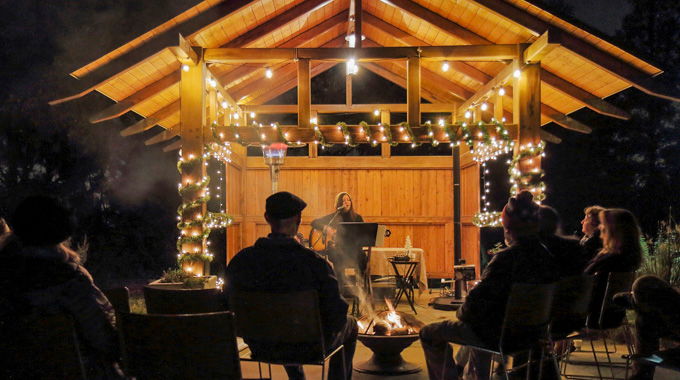
Photo courtesy of California Botanic Garden
Come find your glow this winter during Luminaria Nights at California Botanic Garden. This holiday lights experience is like no other in Southern California, featuring peaceful luminaria- and string light-lined paths between beautifully illuminated musical venues. With at least three live performers each night, art installations, and food, sweet treats, and drinks available for purchase, Luminaria Nights highlights the quiet evening beauty of CalBG’s unique native plant gardens. New this year: Members Only Preview Night on Friday, December 8th! Become a CalBG member today to purchase tickets for this special night. Join at or upgrade to the Acorn or Family Plus membership level to gain access to our December 8th VIP reception with exclusive treats, drinks, and music.
When: Dec. 9-10, 15-16 @ 6- 9 p.m.
Where: California Botanic Garden, 500 N. College Avenue, Claremont
Tickets: $15 for students; $20 adults at calbg.org
Night of 1000 Lights

It’s Candy Land!
The Gardens’ holiday décor will be reminiscent of the vintage board game we all remember as children.
Stroll along the Rainbow Trail, past the Lollypop Woods and the Gumdrop Mountains, through the Peppermint Stick Forest, and the glistening light tunnel, on your way to the Candy Heart Carnival, featuring carnival games for kids of all ages.
Visit the Molasses Swamp, the Old Peanut Brittle House, and the Candy Land Express Train on your way to visit Santa in his workshop. Then head to the fire pit and whip up your own batch of s’mores. The Garden Shop will be open and is a must-see for unique holiday gift ideas. Make a wish at “The Wishing Tree” and create lasting memories with friends and family celebrating the holidays at Sherman Library & Gardens.
When: Two Member Nights on December 6 & 8
General Public Nights on December 9, 10, 14, 15, 16, 17, 18, 19, 20, 21 and 22
6 pm – 9 pm each night with three entry times each night: 6:00 pm, 7:00 pm & 8:00 pm.
Where: Sherman Library & Gardens, 2647 East Coast Highway, Corona del Mar
Tickets: $35 for general admission; $25 for members at thesherman.org

Keeping Current Matters | Nov 3, 2023
Some Highlights
- If you’re ready to buy a home but are having a hard time affording it on your own, or, if you have aging loved ones you need to care for, you might want to consider a multi-generational home.
- Living with siblings, parents, and even grandparents can help you save money, give or receive childcare, and spend quality time together.
- Let’s connect to find a home in your area that’s perfect for you and your loved one’s needs.

Christine Almarines @christine_almarines
Realtor DRE# 01412944 | 714-476-4637

Michelle Kim @michellejeankim_homes
Realtor DRE# 01885912 | 714-253-7531

Anaid Bautista @singlemomrealtor
Realtor DRE# 02179675 | 949-391-8266
While California winters are relatively mild compared to most of the country, it is still important to perform home winterization tasks in the fall. While Southern Californians might not experience the seasons like those in other parts of the country, there is a perceptible change in the air we all recognize as one season moving into another. Once we sense the upcoming 60-degree chill, Southern California residents should consider preparing their homes for temperature dips, occasional rain, and the intermittent morning frost.
Regardless of where you live, winterizing your home is a good investment of time and can save money each year on heating costs. As with all things home-related, maintenance costs are generally lower when homeowners proactively prepare their home for winter weather instead of waiting until repairs require professional attention.
Here’s how to winterize a Southern California home:
Prepare Your Furnace
Many homeowners take their central heating systems for granted, but a furnace that is improperly maintained performs less efficiently. This can lead to higher energy bills and could result in system malfunction and cause safety hazards. To prevent these kinds of issues, it is best to be proactive about furnace maintenance, especially before winter.
Here are some key steps:
- Replace the air filter in your furnace each month. Locate the filter and pull it out. Slide the new filter into the slot, following the arrows on the frame of the filter.
- Consider upgrading to a pleated filter, HEPA filter or electrostatic filter. These filters increase the energy efficiency of your furnace and allow the warm air to flow unimpeded through your home.
- Clean your air vents and ducts. Remove the vent covers with a screwdriver. Use the extension hose of your vacuum to remove the dust.
- Inspect the blower belt for cracks. Turn off the power to the furnace at the main circuit breaker. Use a screwdriver to remove the steel cover of the air handler. The blower belt is the largest rubber belt that you see. Replace the belt if it is cracked.
- Adjust your programmable thermostat so it automatically lowers the temperature while you are asleep or away from your home. Consider retrofitting your older home with one of these thermostats; newly built homes in California must be outfitted with a set-back thermostat.
- Inspect the exhaust flue outdoors to ensure it is free of obstructions such as branches or animal nests.
- Keep the area around your furnace unit free of debris and clutter.
- Open all your air vents. Remove furniture, boxes and clutter that get in the way of air flowing from the vents.
Inspect Your Water Heater
Cold showers are never fun once winter is in full force. You can reduce the chances of water heater failure during winter by performing an inspection in the fall. Look at the tank for any signs of corrosion or blackened areas near the burner. Corrosion can be coming from a leak inside of the tank or from high moisture content in the area. Blackened areas near the burner are almost always from improper combustion or back drafting. Insulation blankets can be purchased to wrap water heaters, but when blankets are installed on gas water heaters, the fire hazard may outweigh the minor if any cost savings of the wrapping. Insulated covers on newer water heaters are worthless as far as insulation goes. More often than not they pose greater fire hazards because of the proximity to the draft diverter or the combustion chamber at the base.
Check All Other Air Ducts
Find exposed ducts wherever they may be (in the attic or crawlspaces) and repair all areas where pipes are pinched and restricting the flow of heated air into the house. Fix gaps with metal-backed tape, which is longer lasting and more durable than duct tape. Ducts also should be vacuumed at least once every two years to clear out hair, dust and other debris that can clog the ducts and the air.
Seal Windows and Doors
During the winter, you want to make sure that your doors and windows are airtight. Otherwise, you furnace will just be blowing money out through those cracks. Start with these simple ways to prevent cold air from seeping through your windows and doors.
- Check the glass to make sure your panes are in good shape and free of cracks.
- Add insulation if you can access the area behind the window or door trim. Adding batt insulation or spray foam insulation can stop air from sneaking in.
- Add weather stripping to all doors and windows for added protection from drafts and cold weather.
- Caulk around windows and doors.
Insulate
For optimal energy efficiency, your home should be properly insulated from the roof down to its foundation. Experts will tell you that regardless of climate, homeowners need a minimum of 12 inches of insulation in the attic. Because most ceiling joists are 11 inches maximum, if can see the ceiling joists in your attic, you don’t have enough insulation.
Insulate and air seal any knee walls — vertical walls with attic space directly behind them — in your home as well. In addition, if you’re building a new home or remodeling, make sure any attic decking that provides additional storage space or a platform for a heating and/or cooling unit or hot water tank is raised above the ceiling joists to leave room for adequate insulation. If the air distribution system is not within the conditioned space but within the attic, insulating the rafters will enclose the distribution system.
Check and Upgrade Safety Devices
Test existing smoke alarms and consider upgrading to dual smoke alarm/carbon monoxide detectors with smart technology that connects with other wireless technology in your home and monitor on your mobile phone. Carbon monoxide is an odorless, invisible, and extremely dangerous gas, which can result in death if inhaled over a period of time, and can be given off by the most common appliances in your home.
Prepare Your Fireplace
Have your fireplace chimney cleaned and inspected. Remove smoke and soot stains from the fireplace surround and chimney facing by spraying the surface with water followed by scrubbing with a mixture of all-purpose cleaner and water. You can also try a mixture of vinegar and water. For marble and stone surfaces, follow the water with a mixture of dishwashing liquid and water. Clean glass fireplace doors with a vinegar and water solution, adding some ashes from the fireplace to gently scrub the glass.
Reverse Ceiling Fans
Many people don’t even realize that there are multiple settings on their ceiling fans. You can use your ceiling fans to assist in keeping your home warm in the winter by revering the direction of the blades. In the winter the blades should rotate clockwise. Clockwise rotation pushes the warm air down and recirculates it throughout the room. Alongside your heater, your home will stay toasty all winter long.
Final Thoughts
As cold weather approaches, it is important to take a few preventative measures to protect your home through the chilly months. Winterizing is generally a task that can be done relatively inexpensively, but will make a big difference in how comfortable your home is, and could end up saving you money on energy bills, too. In fact, many very effective home weatherproofing jobs are something that homeowners can complete without professional help.
If your system needs repair or inspection before winter, contact us for our Preferred HVAC specialists in your area by calling or texting Christine at (714) 476-4637.
These local craft fairs in Orange County are scheduled to make their showings in early November, helping you get started on your Christmas shopping or get some inspiration early on in the holiday season! Specialty items you’d find at these booths are handmade and let the gift recipient know that you care, but without spending a fortune. Win-win for all!
*** Please confirm the dates/times/locations for the following events as they are subject to change.
- November 4, 2023
- 10AM – 4PM
- Orange County Great Park Palm Court Arts Complex
- More than 100 artists selling holiday decorations, handblown glass, ceramics, jewelry and more. Come for the holiday music, stay for the shopping!
- November 11, 2023
- 9:00AM – 1:00PM
- Salem Lutheran Church
- 6500 E Santiago Canyon Road, Orange
- Over 20 unique holiday vendors
- November 12, 2023
- 11:00AM – 5:00PM
- Old Town Tustin – 245 El Camino Real
- This is a free biannual event with over 150 vendors selling art, crafts, small businesses, food and music vendors. Vendors are selected by jury to ensure quality. Entertainment and food trucks are strategically placed throughout the venue for shoppers’ convenience.
- Happens rain or shine.
- Sundays, November 12 & 19
- Sundays, December 3, 10 & 17
- 10:00 AM – 4:00 PM
- Old World Village: 7561 Center Avenue, Huntington Beach, CA
- November 7, 2023
- American Legion Post 277: 230 S. Bradford Ave., Placentia
- 5:30PM – 7:30PM
- Free Admission
- Shop small to find unique holiday gifts for friends and family. There will also be food and music.
- Nov. 2 – Nov. 5; Nov. 16 – Nov. 19; Dec. 7 – Dec. 17, 2023
- 7227 Edinger Ave., Huntington Beach
- Free admission
- Shop for holiday grifts from over 100 vendors and find unique and creative gifts including clothing, décor, soaps, candles, baked goods, and much more.
- November 4, 2023
- 10AM – 4PM
- Great Park Palm Court Arts Complex: 8000 Great Park Blvd., Irvine
- Unique handmade goods, holiday decorations, jewelry, etc.
- Live festive holiday music
- Free admission
- November 17-18, 2023
- Brea Community Center, 695 Madison Way, Brea CA
- Over 200 vendors displaying handicrafts, holiday gifts, food and collectibles.
- Saturday, November 18, 2023
- Norman P. Murray Community Center – 24932 Veterans Way, Mission Viejo
- 8AM – 5PM
- Admission is free
- Features over 80 artisans with handcrafted décor, specialty items, and gifts.
- Friday, November 17th for five consecutive 3-day weekends, through December 17th.
- 10:00 AM – 7:00 PM
- Sawdust Art Festival, 935 Laguna Canyon Rd., Laguna Beach, CA
- 180 artists and makers bring the Christmas spirit at the famous Sawdust Art Festival in Laguna Beach.
- Tickets required for entry
- Admission fees apply (adults – $10, $7 seniors, $5 ages 6-12, 5 and under free, but a ticket is required for capacity purposes)
- November 19, 2023
- 10:30AM – 1PM & 1:30PM – 4PM
- Old World Village: 7561 Center Avenue, Huntington Beach, CA
- A Christmas fair located in Huntington Beach, you’ll find handmade gifts, clothing, fun, baked goodies, and Glogg.
- Saturday, December 2, 2023
- 3PM – 7PM
- Village Green Park: 12732 Main Street, Garden Grove
- Shop from vendors for unique handmade goods
- Enjoy other Winter In The Grove festivities and a visit from Santa
- Saturday, December 2, 2023 | 3PM – 7PM
- Sunday, December 3, 2023 | 10AM – 3PM
- Orange County Great Park: 8000 Great Park Blvd., Irvine
- Free admission
- Unique handmade goods, crafts, jewelry, clothing, and more
- Saturday includes the annual tree lighting event
- Sunday includes annual holidayz at the park pop-up event
- December 9, 2023
- 10AM – 4PM
- Ehlers Event Center: 8150 Knott Ave, Buena Park
- Free Admission
- Over 100 Vendors plus snow slide and play area, petting zoo, food and games
- Visit from Santa Claus
- November 8-11, 2023
- 10:00AM – 7:00PM
- 1044 Westminster Mall, Westminster, CA 92683
- $5 admission – opening day only; free admission thereafter
- Veteran’s, Thanksgiving, and Christmas Boutique and craft fair.
AND
- November 29-December 2, 2023
- 10:00AM – 7:00PM
- 1044 Westminster Mall, Westminster, CA 92683
- $5 admission – opening day only; free admission thereafter
- Hanukkah, Christmas, and New Year Boutique and craft fair.
- This craft fair specializes in handcrafted art, holiday crafts and accessories, including magical accessories for your garden.
AND
- ALL NEW CHRISTMAS STORE
- December 6-17, 2023
- Mon-Sat 11:00AM – 7:00PM
- Sun 12:00PM – 6:00PM
- 1044 Westminster Mall, Westminster, CA 92683
- Free Admission
- Hanukkah, Christmas, and New Year Boutique and craft fair.
- This craft fair specializes in handcrafted art, holiday crafts and accessories, including magical accessories for your garden.
- December 2, 2023
- 10AM – 3PM
- South Shores Church: 32712 Crown Valley Parkway, Dana Point
- Shop from over 50 vendors at this outdoor holiday craft faire and enjoy food trucks and ocean views.
- Ocean View High School
- 17071 Gothard St, Huntington Beach
- December 2, 2023
- 10AM – 3:30PM
- Holiday crafters, artisans, merchandise of all kinds, with music and a kids zone.
- OC Fair & Event Center – 88 Fair Drive, Costa Mesa, CA
- December 3, 2023
- 11:00 AM – 5:00 PM
- $10 for parking
- Free holiday market with over 100 local businesses. Home décor, seasonal items, clothing, pet goodies, holiday gifts, hand crafted items. Free photos with Santa, food and drinks, DIY workshops, Live DJ, holiday fun, and more.
- December 3-4, 2023
- 12:00 PM – 5:00 PM
- Chemers Gallery, 17300 17th Street, Tustin CA
- Shop for all kinds of art, from the wearable to the edible, at this holiday fair. Handcrafted jewelry, wearable fiber, ceramics, vegan chocolates, artisan roasted coffee, local honey, and more.
Keeping Current Matters | Oct 24, 2023
When it comes to selling your house, you’re probably trying to juggle the current market conditions and your own needs as you plan your move.
One thing that may be working in your favor is how few homes there are for sale right now. Here’s what you need to know about the current inventory situation and what it means for you.
The Supply of Homes for Sale Is Far Below the Norm
When you’re selling something, it helps if what you’re selling is in demand, but is also in low supply. Why? That makes it even more desirable since there’s not enough to go around. That’s exactly what’s happening in the housing market today. There are more buyers looking to buy than there are homes for sale.
To tell the story of just how low inventory is, here’s the latest information on active listings, or homes available for sale. The graph below uses data from Realtor.com to show how many active listings there were in September of this year compared to what’s more typical in the market.
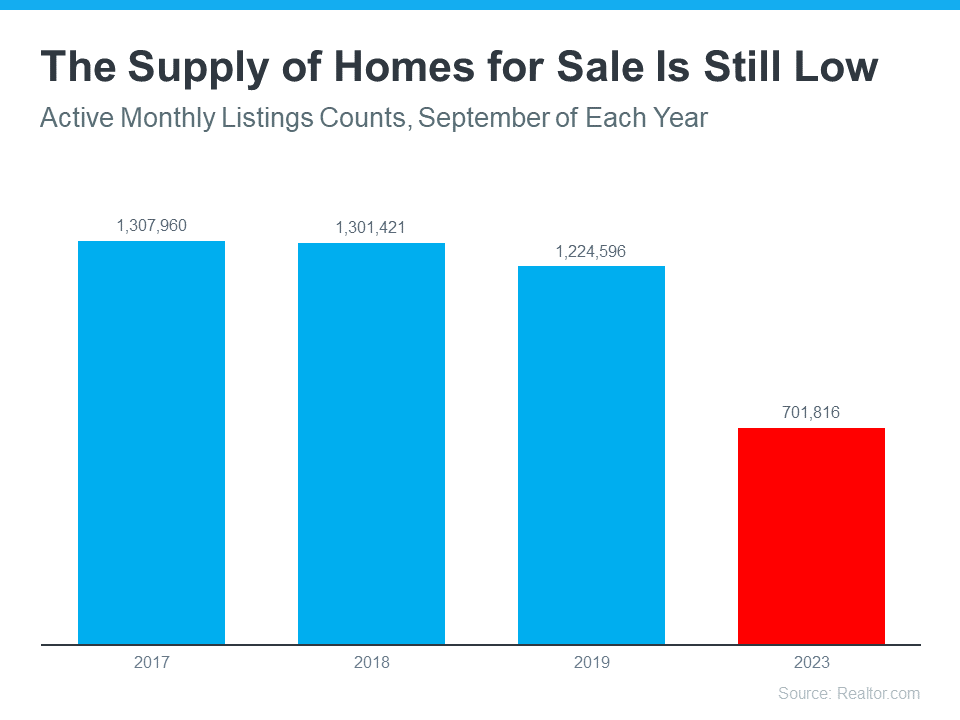
As you can see in the graph, if you look at the last normal years for the market (shown in the blue bars) versus the latest numbers for this year (shown in the red bar), it’s clear inventory is still far lower than the norm.
What That Means for You
Buyers have fewer choices now than they did in more typical years. And that’s why you could still see some great perks if you sell today. Because there aren’t enough homes to go around, homes that are priced right are still selling fast and the average seller is getting multiple offers from eager buyers. Based on the latest data from the Confidence Index from the National Association of Realtors (NAR):
- 69% of homes sold in less than a month.
- 2.6 offers: the average number of offers on recently sold homes.
An article from Realtor.com also explains how the limited number of houses for sale benefits you if you’re selling:
“. . . homes spent two weeks less on the market this past month than they did in the average September from 2017 to 2019 . . . as still-limited supply spurs homebuyers to act quickly . . .”
Bottom Line
Because the supply of homes for sale is so low, buyers desperately want more options – and your house may be just what they’re looking for. Let’s connect to get your house listed at the right price for today’s market. You could still see it sell quickly and potentially get multiple offers.
Realtor.com | Oct 3, 2023
‘Tis the season for houseguests! Whether they’re coming over for a party, a holiday hiatus, or a takeover of your home while you’re out of town, you’ve likely got a human influx to deal with over the holidays. Don’t get us wrong—we think having more people around can be a merry thing! But going hand in hand with all that merrymaking is the mess that they can make of your home.
Still, though, there’s hope: With the right prep work, you can stave off many disasters and essentially guest-proof your house. Here are some tactics to protect your floors, furniture, and other valuables from harm. (Bonus: Many of these tips help safeguard your guests, too.)
Hack No. 1: Guard your entryway
It’s important to start things off on a good foot, literally. Make sure your outdoor lights work and de-ice the path to your door if necessary to reduce the chance of slips, falls, and last-minute trips to the ER. Then shake out the welcome mat.
“A mud-catching entryway mat can help prevent a good amount of dirt and debris from getting tracked all over your floor or carpet,” says Jamie Novak, author of “Keep This Toss That.” In fact, you might consider placing two mats outside your front door—side by side or one in front of the other on the steps—so guests take more steps on the mat before entering your home. Double the fun!
Also, since your foyer is bound to get overrun with coats and shoes, put away any of your own that you don’t need handy that day. Another tip to avoid falls is to tape down any extension cords (of which there may be many this time of year owing to holiday lights) in the entry or hallway, or camouflage them with cord covers. And rug pads placed under area rugs will help keep them in place against the holiday foot traffic.
Hack No. 2: Prep your kitchen
As the number of guests increases, so does the strain on the plumbing system in your home.
The kitchen sink is a revolving door during the holidays and is the most vulnerable to getting clogged.
“Be sure not to clean dishes off in the sink. … Instead, dump all leftover food scraps into the trash before putting the dish in the sink to prevent clogs,” says Mike Agugliaro, co-owner of New Jersey–based Gold Medal Service plumbing company.
Fortify your trash cans too: “Triple line the can so you can save time replacing the liner every third time,” says Novak. “Also, place a few layers of newspaper at the bottom of the trash-can liner to soak up grease and liquid. That way, if the bag is pierced the liquid won’t leak.”
Hack No. 3: Bolster your bathroom
Skip this part if you must. But otherwise, let’s get down to the nitty-gritty. The bathroom is just a disaster waiting to happen, especially if Uncle Rupert overimbibes on the spiked eggnog. Again. Or a thousand other bad-case scenarios. But there are ways to keep your pipes from suffering the consequences.
“Today’s toilets use less water and are easier to clog,” says Agugliaro. “Plus, plusher types of toilet papers can’t flush easily. Instead, use brands like Scott, which are thinner and can more easily pass through drains. And never leave paper towels in your bathroom, or there will surely be a chance of a clog.”
Novak also suggests creating a handwritten tent card that states special info for guests like, “Our pipes/septic tanks are antique, please flush only paper.”
Other smart bathroom moves? “Move medications up high in the cabinet, out of reach,” says Novak. “Also prevent guests from rummaging through your closets and drawers by filling a basket with extra paper goods, hand towels, feminine products, and air freshener. You might even add a laundry stain stick to catch spills before they set.”
Hack No. 4: Preserve your valuables
If you have precious items or heirlooms that would devastate you if damaged, hide or make them off-limits.
“Before the holiday season arrives, walk through your home and take stock of items you do not want broken or damaged—such as family heirloom pieces or a Tiffany vase from your wedding,” says Jeffrey Weldler, interior decorating expert at Vänt Wall Panels. “Go with the old saying ‘better safe than sorry,’ and put these items in a box tucked into the closet until after your company has gone.”
This also applies for your kids’ special toys or even sequined pillows or furry rugs that might be tough to clean.
Novak also suggests creating a sort of VIP area.
“Keep your guests in a few key areas by locking doors to others rooms or using decorations as deterrents to entering other parts of your home,” says Novak. “A strand of lights across the staircase signals ‘Please don’t go up there,’ or you can hang a printed sign.”
Hack No. 5: Create a cleanup kit
No matter how careful you are, you are bound to have at least one person spill wine or gravy somewhere that makes you shudder. For this inevitability, consider putting a few go-to cleaning items in a basket—a sponge, microfiber cloth, dustpan, brush (think broken glass), and all-purpose cleaner—and place it out. You might add a comical “oops” sign to the container so guests don’t feel awkward if they have an accident and need to grab it.
“Having a few essentials on hand means you save time should you need them, plus you or your guests won’t have to leave the party to rummage through your linen closet to find a rag,” says Novak. In other words, just spray, wipe, and let the festivities continue!
Keeping Current Matters | October 18, 2023
If you’re considering selling your house right now, it’s likely because something in your life has changed. And while things like mortgage rates play a big role in your decision, you don’t want that to overshadow why you thought about making a move in the first place.
It’s true mortgage rates are higher right now, and that has an impact on affordability. As a result, some homeowners are deciding they’ll wait to sell because they don’t want to move and have a higher mortgage rate on their next home.
But your lifestyle and your changing needs matter, too. As a recent article from Realtor.com says:
“No matter what interest rates and home prices do next, sometimes homeowners just have to move—due to a new job, new baby, divorce, death, or some other major life change.”
Here are a few of the most common reasons people choose to sell today. You may find any one of these resonates with you and may be reason enough to move, even today.
Relocation
Some of the things that can motivate a move to a new area include changing jobs, a desire to be closer to friends and loved ones, wanting to live in your ideal location, or just looking for a change in scenery.
For example, if you just landed your dream job in another state, you may be thinking about selling your current home and moving for work.
Upgrading
Many homeowners decide to sell to move into a larger home. This is especially common when there’s a need for more room to entertain, a home office or gym, or additional bedrooms to accommodate a growing number of loved ones.
For example, if you’re living in a condo and your household is growing, it may be time to find a home that better fits those needs.
Downsizing
Homeowners may also decide to sell because someone’s moved out of the home recently and there’s now more space than needed. It could also be that they’ve recently retired or are ready for a change.
For example, you’ve just kicked off your retirement and you want to move somewhere warmer with less house to maintain. A different home may be better suited for your new lifestyle.
Change in Relationship Status
Divorce, separation, or marriage are other common reasons individuals sell.
For example, if you’ve recently separated, it may be difficult to still live under one roof. Selling and getting a place of your own may be a better option.
Health Concerns
If a homeowner faces mobility challenges or health issues that require specific living arrangements or modifications, they might sell their house to find one that works better for them.
For example, you may be looking to sell your house and use the proceeds to help pay for a unit in an assisted-living facility.
With higher mortgage rates and rising prices, there are some affordability challenges right now – but your needs and your lifestyle matter too. As a recent article from Bankrate says:
“Deciding whether it’s the right time to sell your home is a very personal choice. There are numerous important questions to consider, both financial and lifestyle-based, before putting your home on the market. . . . Your future plans and goals should be a significant part of the equation . . .”
Bottom Line
If you want to sell your house and find a new one that better fits your needs, let’s connect. That way, you’ll have someone to guide you through the process and help you find a home that works for you.
For Sellers, Interest Rates, Demographics, Selling Myths



















